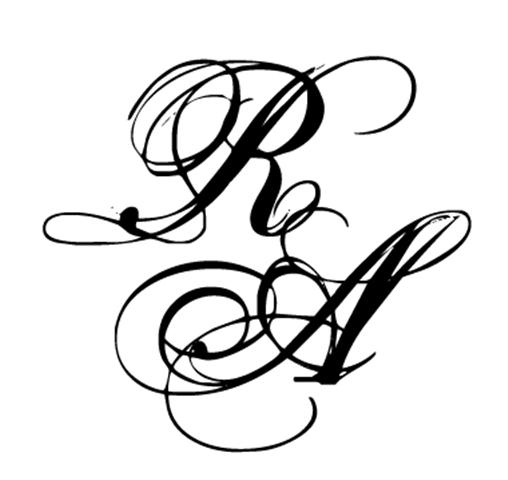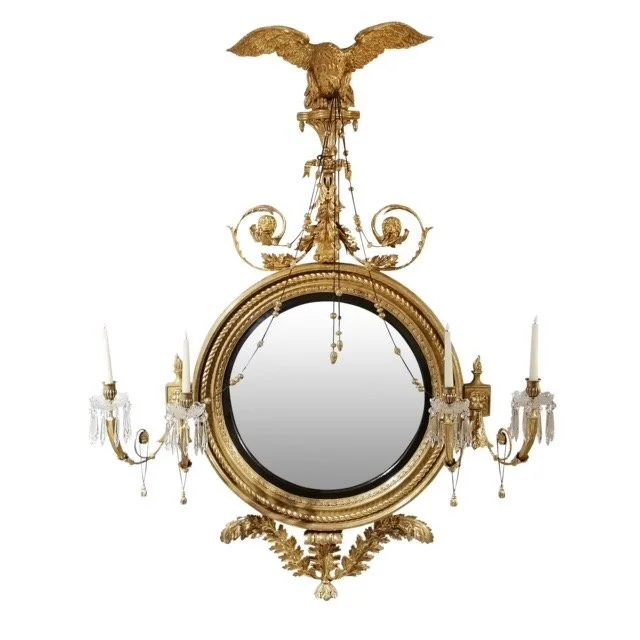An Irish Regency giltwood and ebonised four-light convex girandole POA
An Irish Regency giltwood and ebonised four-light convex girandole POA
An Irish Regency giltwood and ebonised four-light girandole, signed and dated verso Arthur Williams, July 10th, 1819, Williams is a craftsman known to have worked for Richard Jackson of Dublin, circular convex plate in a plain ebonised slip with moulded and rope bound frame above a scrolled and tied triadic foliate apron, echoed in the tied foliate scrolls of the cresting and the elegant tied foliate scrolls supporting the plinth above, pendant acorns to either side, the whole crested by a fine eagle with outspread wings, his talons clasping a rocky base and having the six tasselled and beaded chains gathered into his powerful beak. Graceful foliate scrolls terminate in lion mask finials to either side with a further pair of lion masks on squared backs topped by scrolled flaming torches with tied oak leaves beneath, each lion mask holding a beaded and tasselled chain, then below a pair of elegant scrolling double gilt bronze candle arms supporting gilt bronze candle cups having cut glass bobeches with surrounding pendant prisms.
The girandole has some restorations and re-gilding. The glass has been replaced but we retain the original. The backboard carries an inscription in pencil, Arthur Williams, July 12 1815/19
Size: 62 inches (158cm) high; 46 inches (117cm) wide; 13.75 inches (35cm) deep
Price on application
Stock No.: VT20487
🔶 On Consignment
Richard Jackson (fl.1786-1827) owned the Looking Glass Warehouse on Essex Bridge, Dublin. The Jacksons were a family of carvers, gilders and looking glass manufacturers established by Thomas Jackson at no.5 Essex Bridge sometime in the 1740s, Jackson supplied significant glass and girandoles to the Earl of Aldborough, c.1793-98, for his magnificent Dublin townhouse, including: a large Chemney Glass w’th Ornam’t & arms for 4 Candles, £18 10s’ (The Knight of Glin & James Peill Irish Furniture Yale 2007 p.168)
The signature of Arthur Williams appears on at least one girandole carrying the Jackson label. It is thought most likely he was a member of the family that later became Mack, Williams and Gibton. A pair of convex girandoles with the Jackson of Dublin label, accompanied by an inscription on the reverse, 'Arthur Williams Sept 29 1807', was sold anonymously at Christie’s in 1997 (Important English Furniture 13 November, lot 124).
The girandole has provenance to Prehen House, Co. Derry, a Listed Grade A mansion, built in 1740 for Colonel Andrew Knox (1709-74), MP for Co. Donegal, and described as perhaps the finest early Georgian country house in Northern Ireland. The Knox family lost ownership of Prehen House in 1914 and by the early 1970s the house was on the verge of dereliction. It was saved by the intervention of Julián Peck, son of Winifred Knox, and his American-born wife Carola: the couple responsible for the fine restoration of Rathbeale Hall (c.1734-51), Co. Dublin. Carola Peck, a dedicated member of the Irish Georgian Society with a comprehensive knowledge of early 18th Century interiors and furnishings, determinedly sought out the best and most apposite pieces for such an important house as Prehen.
Throughout the 18th and into the 19th Century, increasing trade and economic development together with an element of political independence, brought considerable wealth to the landed aristocracy and merchant classes of Ireland. The Irish craftsmen of the late 18th and early 19th Century, were clever and talented, always aware of the prevailing taste of the time they brought their own observations, style, exuberance and charm to the decorative arts. The decoration of this girandole is relatively restrained but each symbol displays the craftsman’s knowledge of the significance of classical motifs: In Greek mythology the flaming torch is a symbol of life and light, derived from Aurora, goddess of the dawn; the oak is sacred to the Roman god of the sky, Jupiter, but is also important to the ancient Druids and Celtic myth; the lion, king of beasts, has strength and power - to be interpreted as the pinnacle of aristocratic attributes; the eagle is a timeless symbol of triumph and victory; and abundant foliage heralds the promise of spring, abundance and new growth.
The owners of such fine houses like Prehen supported an extensive luxury trade in Dublin - huge numbers of cabinet-makers, upholders, carvers, gilders and glass grinders flourished at this time. And looking glasses were probably one of the most expensive status symbols that could be bought - a certain sign of the wealth and status of the house owner






